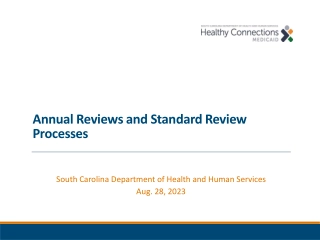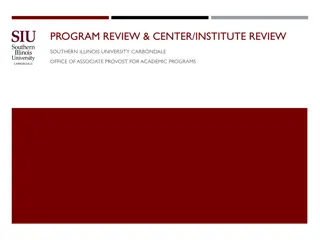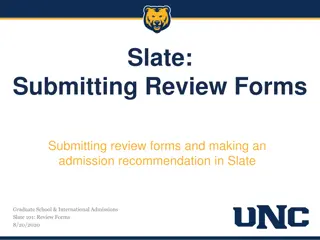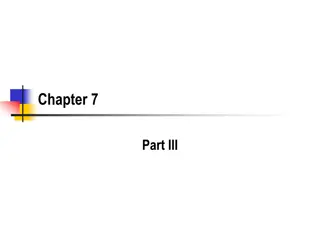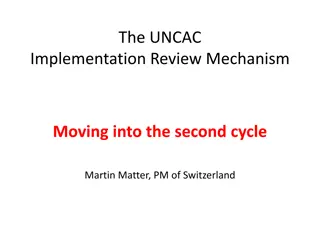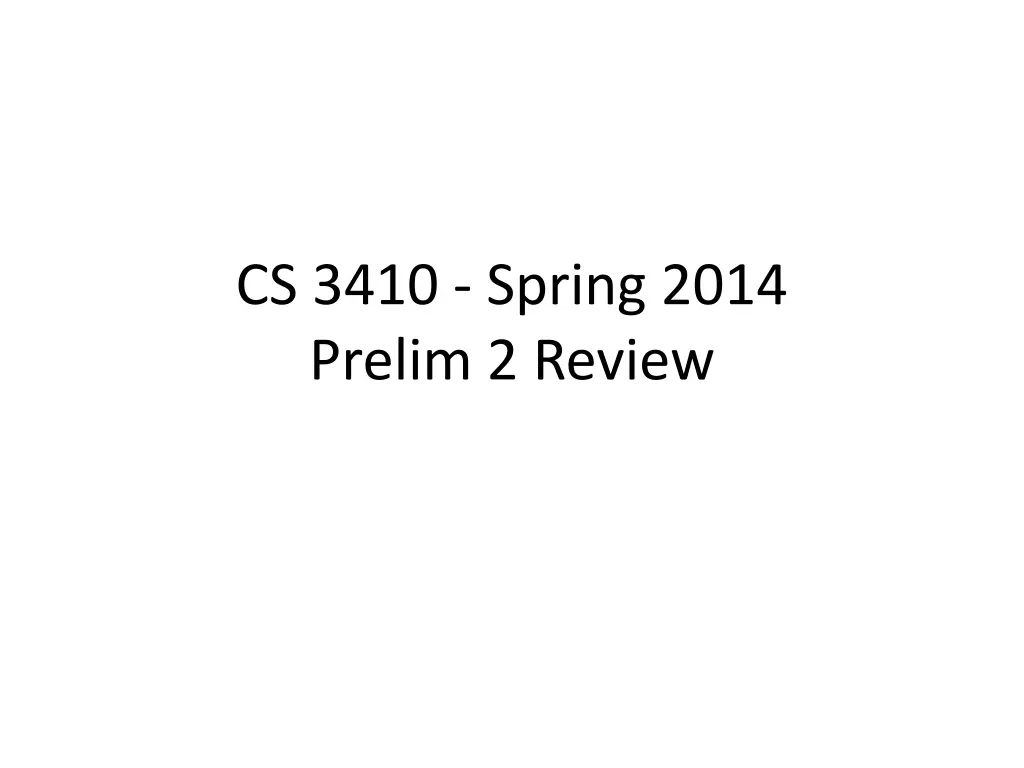
CS 3410 Spring 2014 Prelim 2 Review and Calling Conventions
Dive into the intricate details of CS 3410 with a review of Prelim 2 topics including Calling Conventions, Linkers, Caches, Virtual Memory, Traps, Multicore Architectures, and Synchronization. Explore translating C code to MIPS assembly, understanding stack frame sizes, and managing register allocation for variables.
Download Presentation

Please find below an Image/Link to download the presentation.
The content on the website is provided AS IS for your information and personal use only. It may not be sold, licensed, or shared on other websites without obtaining consent from the author. If you encounter any issues during the download, it is possible that the publisher has removed the file from their server.
You are allowed to download the files provided on this website for personal or commercial use, subject to the condition that they are used lawfully. All files are the property of their respective owners.
The content on the website is provided AS IS for your information and personal use only. It may not be sold, licensed, or shared on other websites without obtaining consent from the author.
E N D
Presentation Transcript
CS 3410 - Spring 2014 Prelim 2 Review
Prelim 2 Coverage Calling Conventions Linkers Caches Virtual Memory Traps Multicore Architectures Synchronization
Calling Convention Prelim 2, 2013sp, Q5: Translate the following C code to MIPS assembly: int foo(int a, int b, int c, int d, int e) { int tmp = (a|b) (d&e); int q = littlefoo(tmp); int z = bigfoo(q,tmp,a,b,c); return tmp + q z; }
Calling Convention (cont.) int foo(int a, int b, int c, int d, int e) { int tmp = (a|b) (d&e); int q = littlefoo(tmp); int z = bigfoo(q,tmp,a,b,c); return tmp + q z; } Question 1: how many caller/callee save registers for which variables? Callee save (need the original value after a function call): a, b, c, tmp, q Caller save (do not need to preserve in a function call): d ($a3), e, z ($v0) Question 2: how many outgoing arguments we should leave space for? 5: bigfoo(q, tmp, a, b, c) Question 3: what is the stack frame size? ra + fp + 5 callee-save + 5 outgoing args = 12 words = 48 bytes
Calling Convention (cont.) int foo(int a, int b, int c, int d, int e) { int tmp = (a|b) (d&e); int q = littlefoo(tmp); int z = bigfoo(q,tmp,a,b,c); return tmp + q z; } #prolog ADDIU $sp, $sp, -48 # (== 5x outgoing args, 5x $sxx, $ra, $fp) SW $ra, 44($sp) SW $fp, 40($sp) SW $s0, 36($sp) # store, then $s0 = a SW $s1, 32($sp) # store, then $s1 = b SW $s2, 28($sp) # store, then $s2 = c SW $s3, 24($sp) # store, then $s3 = tmp = (a|b) (d&e) SW $s4, 20($sp) # store, then $s4 = q = littlefoo(tmp) ADDIU $fp, $sp, 44
Calling Convention (cont.) int foo(int a, int b, int c, int d, int e) { int tmp = (a|b) (d&e); int q = littlefoo(tmp); int z = bigfoo(q,tmp,a,b,c); return tmp + q z; } #Initializing local variables MOVE $s0, $a0 MOVE $s1, $a1 MOVE $s2, $a2 OR $t0, $s0, $s1 # $t0 = (a|b) LW $t1, 64($sp) # 64 = 48(own stack) + 16(5th arg in parent) AND $t1, $a3, $t1 # $t1 = (d&e) SUB $s3, $t0, $t1 # $s3 = tmp = (a|b) (d&e)
Calling Convention (cont.) int foo(int a, int b, int c, int d, int e) { int tmp = (a|b) (d&e); int q = littlefoo(tmp); int z = bigfoo(q,tmp,a,b,c); return tmp + q z; } #Calling littlefoo MOVE $a0, $s3 # $a0 = tmp JAL littlefoo NOP #Calling bigfoo MOVE $s4, $v0 # $s4 = q = littlefoo(tmp) MOVE $a0, $s4 # $a0 = $s4 = q MOVE $a1, $s3 # $a1 = $s3 = tmp MOVE $a2, $s0 # $a2 = $s0 = a MOVE $a3, $s2 # $a3 = $s1 = b SW $s2, 16($sp) # 5th arg = $s2 = c JAL bigfoo # bigfoo(q,tmp,a,b,c) NOP
Calling Convention (cont.) int foo(int a, int b, int c, int d, int e) { int tmp = (a|b) (d&e); int q = littlefoo(tmp); int z = bigfoo(q,tmp,a,b,c); return tmp + q z; } #Generating return value ADD $t0, $s3, $s4 # $t0 = tmp + q SUB $v0, $t0, $v0 # $v0 = $t0 z = (tmp + q) z #epilog LW $s4, 20($sp) LW $s3, 24($sp) LW $s2, 28($sp) LW $s1, 32($sp) LW $s0, 36($sp) LW $fp, 40($sp) LW $ra, 44($sp) ADDIU $sp, $sp, 48 JR $ra NOP
Linkers and Program Layout Prelim 2, 2012sp, Q2b: The global pointer, $gp, is usually initialized to the middle of the global data segment. Why the middle? Load and store instructions use signed offsets. Having $gp point to the middle of the data segment allows a full 2^16 byte range of memory to be accessed using positive and negative offsets from $gp.
Linkers and Program Layout Prelim 2, 2012sp, Q2c: Bob links his Hello World program against 9001 static libraries. Amazingly, this works without any collisions. Why? The linker chooses addresses for each library and fills in all the absolute addresses in each with the numbers that it chose.
Caches Prelim 2, 2013sp, Q4: Assume that we have a byte-addressed 32-bit processor with 32-bit words (i.e. a word is 4 bytes). Assume further that we have a cache consisting of eight 16-byte lines
Caches (cont.) How many bits are needed for the tag, index, and offset for the following cache architectures? Direct Mapped Tag: 25, Index: 3, Offset: 4 2-way Set Associative Tag: 26, Index: 2, Offset: 4 4-way Set Associative Tag: 27, Index: 1, Offset: 4 Fully Associative Tag: 28, Index: 0, Offset: 4 Offset is only determined by the size of the cache line. Index is determined by how caches are organized. Tag = 32 index - offset
Caches (cont.) For each access and for each specified cache organization, indicate whether there is a cache hit, a cold (compulsory) miss, conflict miss, or capacity miss.
Virtual Memory (2012 Prelim3, Q4) Virtual Address: 32-bit Page Size: 16 kB Single level page table Each page table entry is 4 bytes. Each process segment requires a separate physical page. 8 kB Stack 8 kB Heap 16 kB = 2^14 B So we need 14 bits Bits for page Offset? Data 8 kB 32-14 bits = 18 bits Bits for page table index? Code 8 kB Physical memory? Each segment size < one page size 4*16 kB = 64 kB Memory layout of a single process 2^18 (PTE s) * 4 bytes = 1 MB Total: 64kB + 1MB
Virtual Memory (2012 Prelim3, Q4) Two level page table Assume there are enough page table entries to fill a second-level page table. (which means every entry in a second level page table will be used) Bits for page offset? 14 bits 16kB/4B=2^12 So we need 12 bits Bits for second level page table? 32-14-12 bits=6 bits Bits for page directory? Physical memory(each process segment requires a separate second-level page table)? 1st: 2^6 * 4B < 2^14B=> 16 kB 2nd: 4 * 16 kB Pages: 4 * 16 kB Total: 16kB+4*16kB+4*16kB
Syscall Kernel User Program syscall(arg1,arg2){ do operation } main(){ syscall(arg1,arg2); } User Stub Kernel Stub handler(){ copy arguments from user memory check arguments syscall(arg1,arg2); copy return value into user memory return syscall(arg1,arg2){ trap return } Hardware Trap Trap Return
Exceptions On an interrupt or exception CPU saves PC of exception instruction (EPC) CPU Saves cause of the interrupt/privilege (Cause register) Switches the sp to the kernel stack Saves the old (user) SP value Saves the old (user) PC value Saves the old privilege mode Sets the new privilege mode to 1 Sets the new PC to the kernel interrupt/exception handler Kernel interrupt/exception handler handles the event Saves all registers Examines the cause Performs operation required Restores all registers Performs a return from interrupt instruction, which restores the privilege mode, SP and PC
Syscall V.S. Exceptions Steps Switches the sp to the kernel stack Saves the old (user) FP value Saves the old (user) PC value (= return address) Saves the old privilege mode Saves cause Sets the new privilege mode to 1 Sets the new PC to the kernel handler Saves callee-save registers Saves caller-save registers Examines the syscall number Examines the cause Checks arguments for sanity Allocate new registers Performs operation Stores result in v0 Restores callee-save registers Restores caller-save registers Performs a return instruction, which restores the privilege mode, SP and PC Exceptions X X X X X X X X X X X X X X Syscall Neither X X X X X X X X X X X X X X
Concurrency (2012 Prelim3, Q5) mutex_lock try: mutex_lock(&m) operation mutex_unlock(&m) LI LL BNEZ SC BEQZ $t1, 1 $t0, 0($a0) $t0, try $t1, 0($a0) $t1, try Load-link returns the current value of a memory location, while a subsequent store-conditional to the same memory location will store a new value only if no updates have occurred to that location since the load-link. Together, this implements a lock-free atomic read- modify-write operation. mutex_unlock SW $zero, 0($a0)
Concurrency (2012 Prelim3, Q5) Critical Section:x = max(x, y) x: global variable, shared; y: local variable &x: $a1 y: $a2 Implement critical section using LL/SC without using mutex_lock and mutex_unlock try: LL $t0, 0($a1) BGE$t0,$a2,next NOP MOVE $t0,$a2 next: SC $t0,0($a1) BEQZ $t0,try NOP
Concurrency(Homework2 Q8) Thread A c[0] = c[0] + 2; c[1] = c[1] + 1; Thread B c[1] = c[1] 2; c[2] = 4; c[0] = 0; MIPS Thread B LW $t0, 4($s0) ADDIU $t0, $t0, -2 SW$t0, 4($s0) ADDIU $t1, $zero, 4 SW $t1, 8($s0) SW $zero, 0($s0) c[0]? MIPS Thread A LW $t0, 0($s0) ADDIU $t0, $t0, 2 SW $t0, 0($s0) LW $t0, 4($s0) ADDIU $t0, $t0, 1 SW $t0, 4($s0) A: LW $t0, 0($s0) ADDIU SW $t0, 0($s0) SW $zero, B: A: SW $zero, LW $t0, 0($s0) ADDIU SW $t0, 0($s0) 0($s0) A: LW $t0, 0($s0) ADDIU SW $zero, SW $t0, 0($s0) $t0, $t0, 2 $t0, $t0, 2 0($s0) $t0, $t0, 2 B: A: =>3 B: =>0 0($s0) =>2
Concurrency(Homework2 Q8) Thread A c[0] = c[0] + 2; c[1] = c[1] + 1; Thread B c[1] = c[1] 2; c[2] = 4; c[0] = 0; MIPS Thread B LW $t0, 4($s0) ADDIU $t0, $t0, -2 SW$t0, 4($s0) ADDIU $t1, $zero, 4 SW $t1, 8($s0) SW $zero, 0($s0) MIPS Thread A LW $t0, 0($s0) ADDIU $t0, $t0, 2 SW $t0, 0($s0) LW $t0, 4($s0) ADDIU $t0, $t0, 1 SW $t0, 4($s0)


